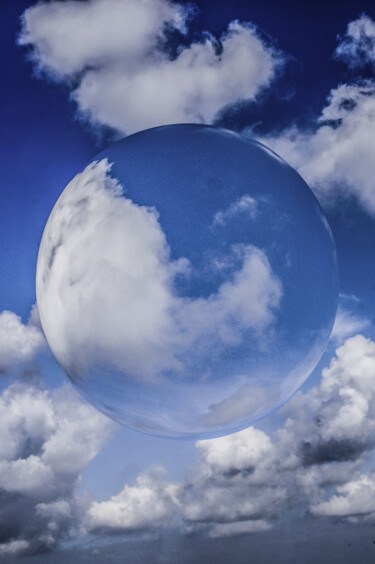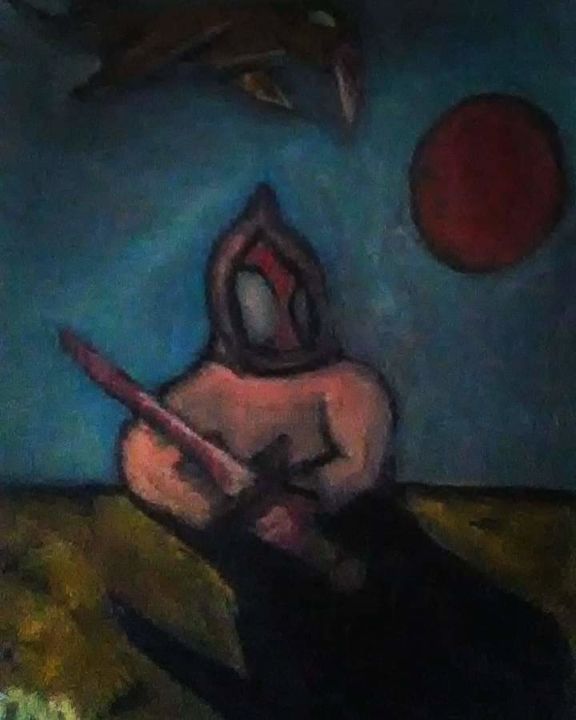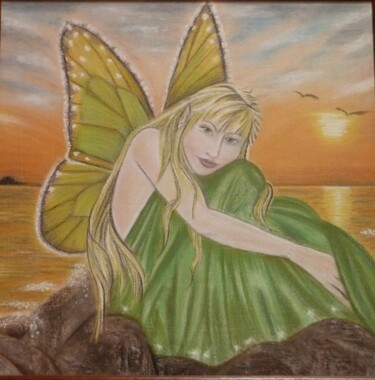
3 Oryginalne dzieła sztuki, limitowane edycje i druki:
Forma sztuki, głównie malarstwo, na którą wpłynął spirytyzm, nazywana jest sztuką spirytystyczną, sztuką duchową, sztuką mediumistyczną lub malarstwem psychicznym. Sztuka duchowa wywarła znaczący wpływ na modernizm, a co za tym idzie na sztukę współczesną.
Georgiana Houghton i Piet Mondrian to dwaj dobrze znani duchowi artyści. Spirytyzm był także inspiracją dla pionierskiej sztuki abstrakcyjnej Wasilija Kandinskiego, Pieta Mondriana, Kazimierza Malewicza i Franciszka Kupki. Houghton i inni artyści spirytystyczni pomogli historykom w rozpoznaniu znaczenia spirytyzmu i środowiska okultystycznego.
W ostatnich latach wielu znawców sztuki uznaje wkład spirytualizmu w rozwój nowoczesnej sztuki abstrakcyjnej. Czołowi współcześni artyści wciąż wchodzą w interakcje z duchowością. Pod kierunkiem znanego brazylijskiego medium-uzdrowiciela Jana Bożego, serbska performerka Marina Abramovic została medium. W jej twórczości obecnych jest wiele elementów spirytystycznych, a także zaczerpniętych z tradycji afroamerykańskich i Aborygenów australijskich.
Różne rodzaje sztuki duchowej
Chociaż wielu artystów było pod wpływem spirytyzmu, bardzo niewielu stworzyło coś, co spirytualiści nazywają „sztuką duchową”. To, co dokładnie stanowi „sztukę duchową”, można podzielić na trzy główne kategorie: „wytrącone” dzieła sztuki; portrety duchów malowane rękami mediów podczas seansów spirytystycznych; oraz dzieła artystów-mediów, którzy twierdzą, że ich rękami kierują duchy.
Media twierdzą, że w pierwszym przypadku „opadu” duchy nie użyły ludzkiego artysty do prowadzenia rąk; zamiast tego sami stworzyli obrazy. W drugim przykładzie sztuki spirytystycznej, portretach duchowych, bardzo popularne wśród mediów było szkicowanie portretów duchów, o których mówili, że były obecne na seansach spirytystycznych w okresie rozkwitu spirytyzmu. „Auragrafy”, które przedstawiają historię, teraźniejszość i przyszłość osoby widzianą przez medium lub jasnowidza, są bliskie drugiemu rodzajowi „sztuki duchowej”.
Według spirytystów trzeci rodzaj „sztuki duchowej” to dzieła architektury, rzeźby i malarstwa, które są tworzone przez duchy kierujące rękami artysty. W drugiej grupie (portrety duchów) mówi się, że duchy często kierują również rękami medium, ale w trzeciej kategorii powstają raczej różne dzieła sztuki niż portrety samych duchów.
„Wytrącone” dzieła sztuki
David Duguid (1832-1907) był pierwszym dobrze znanym medium, które było w stanie „wytrącić” duchowe obrazy. Chociaż Duguid często malował przy pomocy malarzy spirytusowych, podczas swoich seansów jego przewodnicy tworzyli także obrazy „bezpośrednie” (wytrącone).
Bracia Campbell, którzy mieszkali w społeczności spirytystycznej Lily Dale w stanie Nowy Jork, byli prawdopodobnie jednymi z pierwszych mediów, które specjalizowały się w wytrącaniu obrazów. Pomimo tego, że nie byli braćmi, Allen Campbell (1833–1919) i Charles Shourds (1863–1926) dzielili dom i razem prowadzili seanse. Bracia Campbell nigdy nie kładli rąk na płótnie, tworząc swoje najbardziej znane portrety, w tym portrety Napoleona i Abrahama Lincolna, które zostały ukończone publicznie. Nawet dzisiaj turyści i mieszkańcy Lily Dale twierdzą, że mieli duchowe spotkania przed arcydziełami Campbellów.
Siostry Bangs, Elżbieta (1859–1920) i May Mary Elvira (1862–1917), były równie dobrze znane ze swoich pospiesznych portretów zmarłych osób. Chociaż często byli ujawniani jako oszuści, bracia Campbell i siostry Bangs byli silnie chronieni przez znaczną część amerykańskiej społeczności spirytystycznej.
„Swami Laura Horos”, znana również jako Ann Odelia Diss Debar (1849–1911), która twierdziła, że kieruje się duchami kilku europejskich starych mistrzów, była również kojarzona z obrazami duchowymi. Debar została uwięziona w 1901 roku po tym, jak została uznana za winną oszustwa i angażowania się w niemoralne zachowania seksualne w swojej londyńskiej świątyni.
Na początku swojej kariery madame Helena Blavatsky (1831–1891), najbardziej znana i legendarna okultystka XIX wieku i założycielka ruchu New Age, zajmowała się również wytrącaniem duchowych obrazów.
Portrety duchów
Victor Hugo (1802–1855) tworzył swoje duchowe obrazy podczas seansów odbywających się w jego rezydencji na Jersey na Wyspach Normandzkich. W tym czasie prężnie rozwijający się rynek spirytualistyczny wspierany był także przez osoby poszukujące portretów swoich zmarłych bliskich w Stanach Zjednoczonych. Tam Wella Percy (1833–1900) i Lizzie Pet Anderson (1839–1896; prominentni) byli partnerami w życiu i spirytyzmie. Były promowane przez Gallery of Spirit Art, brooklyńską publikację, która zawierała wyłącznie dzieła sztuki stworzone przy pomocy duchów.
Portrety duchowe, które pojawiają się na seansach spirytystycznych, są nadal częścią obecnej sceny spirytystycznej, a dla osób, które myślą, że rozpoznają swoich zmarłych bliskich, mogą być bardzo poruszającym doświadczeniem. Frank Leah (1886-1972) i Coral Polge (1924-2001), dwaj brytyjscy artyści duchowi, byli znani na całym świecie w tej dziedzinie.
Kilkuset duchowych malarzy kontynuuje tradycję, w tym Coral Ryder i Ann Bridge Davies w Wielkiej Brytanii, Francesca Ferraro w Kanadzie i Angelique van Bezouwen w Holandii.
Sztuka stworzona przez duchy kierujące rękami artysty
Brazylijscy spirytyści, którzy praktykują malarstwo transowe, często przekazują dzieła znanych malarzy i rzeźbiarzy. José Medrado (ur. 1961) jest dobrze znany na całym świecie ze swoich transowych obrazów akrylowych i tego, jak łatwo jest mu stworzyć dzieło sztuki z pomocą wielu duchowych asystentów. W stanie transu tworzył obrazy pod wpływem mistrzów malarstwa takich jak Renoir, Vincent Van Gogh, Claude Monet, Matisse, Gauguin, Cassatt, Da Vinci, Morisot, Manet. Również znany jako Medrado w Brazylii jest Luiz Antônio Gasparetto (1949-2018), który maluje i rzeźbi rękami pod kierunkiem Degasa, Sandro Botticellego, Amedeo Modiglianiego i wielu innych znanych artystów.
Niektóre przykłady architektury duchowej również należą do tej kategorii. Za pomocą mediów Iulia Hasdeu (1869–1888) ujawniła plany architektoniczne zarówno swojego słynnego „Zamku Hasdeu” w Câmpina, jak i jej grobu w Bukareszcie. Włoska wioska Rosazza niedaleko Bielli, zbudowana w latach 1880-1899 dla włoskiego senatora i masona Federico Rosazzy (1813-1899), jest kolejnym przykładem architektury duchowej. Został zaprojektowany przez malarza Giuseppe Maffei (1821-1901). Opierał się na planach przekazanych mu przez duchy Augustyna z Hippony (354–430), który nigdy w życiu nie pracował jako architekt, oraz bezimiennego mężczyzny z Volterry w Toskanii.
Wpływ spirytualizmu na sztukę współczesną
W ostatnich latach nastąpił odrodzenie zainteresowania duchowością w branży artystycznej. Muzea poświęcają pośmiertną uwagę zmarłym artystom, którzy szeroko zagłębiali się w mistycyzm i religię. Zachwycająca wystawa Hilmy af Klint w Muzeum Guggenheima w latach 2018–2019, która stała się najczęściej odwiedzaną wystawą w historii muzeum, jest chyba najbardziej znanym tego przykładem. Whitney Museum of American Art pokazało pierwszą indywidualną wystawę prac Agnes Pelton od ponad 20 lat w 2020 roku.
Idea duchowości nabiera coraz większego znaczenia w licznych dyskursach kulturowych XXI wieku, w tym w sztuce współczesnej. Duchowa lub religijna tradycja może być nawiązywana lub reprezentowana w sztuce, która jest uważana za duchową. W przeszłości związek między sztuką a religią służył jako pośrednik między duchowością a sztuką. Jednak pomimo upadku zorganizowanej religii w Europie Zachodniej, wzrosło zainteresowanie duchowością innymi sferami kultury, zwłaszcza sztuką.
Discover contemporary artworks on Artmajeur
Contemporary art is a vibrant constellation of artistic expressions. This creative universe encompasses a wide array of mediums, from paintings, sculpture, and photography to drawing, printmaking, textile art, and digital art, each medium a star shining with its own distinct radiance. Artists use diverse supports and materials to bring their visions to life, such as canvas, wood, metal, and even innovative digital canvases for the creation of virtual masterpieces.
A contemporary painting, for instance, may weave its story through the masterful strokes of acrylic or oil, while a contemporary sculpture might sing its song in the language of stone, bronze, or found objects. The photographic arts capture and manipulate light to produce striking images, while printmaking employs techniques like lithography and screen-printing to produce multiples of a single, impactful image. Textile art plays with fabrics and fibers, whereas digital art pushes the boundaries of creation with innovative technology.
The allure of contemporary art lies in its boundary-pushing nature, its relentless quest for experimentation and its constant reflection of the evolving human experience. This boundless creativity, coupled with its strong social and personal commentary, makes every piece of contemporary art a unique emblem of its time, a mirror held up to the realities and dreams of our complex world. It whispers to us, moves us, provokes thought, and kindles a deep emotional response, stirring the soul of anyone willing to listen. It is, indeed, the language of emotions and ideas, spoken in the dialect of our era.

©2021 Gaudi .C
Origins and history of contemporary art
The story of contemporary art unfolds in the mid-20th century, marked by seismic shifts in artistic expression. Post-World War II, around the 1950s and 1960s, artists began experimenting beyond traditional confines, challenging the norms of what art could be. This revolutionary epoch birthed myriad new movements and artistic forms such as abstract expressionism, pop art, and minimalism. Paintings, once confined by realism, embraced abstraction, as artists used color and form to express emotions and ideas. Notable periods like the advent of pop art in the late 1950s and early 1960s saw artworks mimicking popular culture and mass media, reflecting society’s shifting focus.
The sculptural arts, too, witnessed a metamorphosis. Sculptors started to experiment with new materials and forms, often creating artworks that interacted with the viewer and the surrounding space, fostering a sense of engagement. Drawing, a timeless practice, also evolved, with artists incorporating innovative techniques and concepts to redefine its role in contemporary art.
Photography, a relatively new medium, emerged as a powerful tool in the contemporary art landscape. Born in the 19th century, it truly came into its own in the latter half of the 20th century, blurring the lines between fine art and documentation. Printmaking, a practice dating back to ancient times, saw renewed interest and experimentation with techniques like lithography, etching, and screen printing gaining prominence.
The realm of textile art expanded dramatically, as artists began to appreciate the versatility and tactile quality of fabric and fibers. Artists began using textiles to challenge the boundaries between fine art, craft, and design.
The dawn of digital technology in the late 20th century heralded a new age for contemporary art. Digital art emerged as artists started leveraging new technologies to create immersive, interactive experiences, often blurring the line between the virtual and the physical world.
Through these transformative periods, the essence of contemporary art has remained the same: a dynamic, evolving reflection of the times we live in, continually pushing boundaries and embracing the new, always questioning, always exploring.

©2018 Amazeigh Bouzékri
Evolutions of theses contemporary works in the art market
As we navigate through the 21st century, the dynamic landscape of contemporary art continues to evolve and expand, reflecting our ever-changing world. Contemporary paintings, once primarily confined to two-dimensional canvases, now embrace a multitude of forms and techniques, ranging from mixed media installations to digital creations, each piece a rich a weaving of thoughts, emotions, and narratives. Sculpture, too, has ventured far beyond traditional stone and bronze, with artists incorporating light, sound, and even motion, embodying the ephemerality and flux of the modern world.
Photography, in the hands of contemporary artists, has expanded its horizons, seamlessly blending with digital technology to create breathtaking imagery that challenges our perception of reality. Drawing, as well, has transcended the borders of paper, incorporating multimedia elements and exploratory techniques to redefine its role in the artistic discourse. Printmaking continues to flourish, with contemporary artists using traditional methods in innovative ways to deliver potent social and personal commentaries.
Textile art, once considered a craft, now holds a prominent place in the contemporary art world, with artists using it to explore issues of identity, tradition, and cultural heritage. Meanwhile, digital art, the newest member of the contemporary art family, has revolutionized the way we create and interact with art, presenting immersive experiences that blur the boundary between the virtual and the physical.
These diverse forms of contemporary art hold significant value in the current art market, not only due to their aesthetic appeal but also their ability to encapsulate and communicate complex ideas and emotions. Collectors, curators, and art lovers worldwide seek these works, drawn to their inherent dynamism, their innovative use of materials, and their eloquent expressions of our shared human experience. As a testimonial to our times, these contemporary artworks encapsulate the pulse of our society and the resonance of individual voices, forever etching our collective narrative into the annals of art history.

©2009 Marie-Françoise Le Néen
Famous Contemporary Artists
As we delve into the vibrant realm of contemporary art, we encounter an array of artists who shape this dynamic field. Each a master in their medium - painting, sculpture, photography, drawing, printmaking, textile, or digital art - they push artistic boundaries, reflecting our era and challenging perceptions. Let’s explore these remarkable contributors and their groundbreaking works.
1. Gerhard Richter - Known for his multi-faceted approach to painting, Richter challenges the boundaries of the medium, masterfully oscillating between abstract and photorealistic styles. His works, whether featuring squeegee-pulled pigments or blurred photographic images, engage in a fascinating dialogue with perception.
2. Jeff Koons - A significant figure in contemporary sculpture, Koons crafts monumental pieces that explore themes of consumerism, taste, and popular culture. His iconic balloon animals, constructed in mirror-polished stainless steel, captivate with their playful yet profound commentary.
3. Cindy Sherman - An acclaimed photographer, Sherman uses her lens to explore identity and societal roles, particularly of women. Renowned for her conceptual self-portraits, she assumes myriad characters, pushing the boundaries of photography as a medium of artistic expression.
4. David Hockney - Hockney, with his prolific output spanning six decades, is a pivotal figure in contemporary drawing. His bold use of color and playful exploration of perspective convey an intoxicating sense of joy and an unabashed celebration of life.
5. Kiki Smith - An innovative printmaker, Smith’s work explores the human condition, particularly the female body and its social and cultural connotations. Her etchings and lithographs speak to universal experiences of life, death, and transformation.
6. El Anatsui - A master of textile art, Anatsui creates stunning tapestry-like installations from discarded bottle caps and aluminum scraps. These shimmering, flexible sculptures blend traditional African aesthetic with contemporary art sensibilities, speaking to themes of consumption, waste, and the interconnectedness of our world.
7. Rafael Lozano-Hemmer - A leading figure in digital art, Lozano-Hemmer utilizes technology to create interactive installations that blend architecture and performance art. His work, often participatory in nature, explores themes of surveillance, privacy, and the relationship between people and their environments.
Notable contemporary artworks
The contemporary art landscape is a dynamic patchwork of diverse expressions and groundbreaking ideas, each artwork a unique dialog with its audience. Here are a selection of some renowned contemporary artworks, spanning various media such as painting, sculpture, photography, drawing, printmaking, textile art, and digital art, that have profoundly influenced this vibrant movement.
"Cloud Gate" by Anish Kapoor, 2006 - This monumental stainless steel sculpture, also known as "The Bean," mirrors and distorts the Chicago skyline and onlookers in its seamless, liquid-like surface, creating an interactive experience that blurs the line between the artwork and the viewer.
"Marilyn Diptych" by Andy Warhol, 1962 - An iconic piece of pop art, this silkscreen painting features fifty images of Marilyn Monroe. Half brightly colored, half in black and white, it reflects the dichotomy of celebrity life and its influence on popular culture.
"Rhein II" by Andreas Gursky, 1999 - This photographic artwork, a digitally-altered image of the Rhine River, is celebrated for its minimalist aesthetic. It strips the landscape to its bare essentials, invoking a sense of tranquility and vastness.
"Black Square" by Kazimir Malevich, 1915 - A revolutionary painting in the realm of abstract art, this piece, featuring nothing more than a black square on a white field, challenges traditional notions of representation, symbolizing a new era in artistic expression.
"Puppy" by Jeff Koons, 1992 - This giant sculpture, a West Highland Terrier blanketed in flowering plants, explores themes of innocence, consumer culture, and the interplay between high art and kitsch. It’s a delightful blend of traditional sculpture and garden craft.
"Re-projection: Hoerengracht" by Ed and Nancy Kienholz, 1983-1988 - A room-sized tableau representing Amsterdam’s red-light district, this work combines elements of sculpture, painting, lighting, and found objects. It engages viewers in a stark commentary on commodification and objectification.
"Untitled" (Your body is a battleground) by Barbara Kruger, 1989 - This photomontage, combining black-and-white photography with impactful text, explores issues of feminism, identity, and power. Its potent, confrontational message is a prime example of the power of text in contemporary visual art.
"For the Love of God" by Damien Hirst, 2007 - This sculpture, a platinum cast of a human skull encrusted with 8,601 diamonds, probes themes of mortality, value, and the human fascination with luxury and decadence. It’s a compelling blend of macabre and magnificence.
"Physical impossibility of Death in the Mind of Someone Living" by Damien Hirst, 1991 - This artwork, featuring a tiger shark preserved in formaldehyde, blurs the line between traditional sculpture and biological specimen. It prompts viewers to contemplate mortality and nature’s ferocity.
"One and Three Chairs" by Joseph Kosuth, 1965 - A piece of conceptual art, it presents a physical chair, a photograph of a chair, and a dictionary definition of a chair, thus exploring the relationship between language, picture, and referent in art.
These pieces, in their diversity, exemplify the rich tapestry of contemporary art, each piece a unique commentary on our world and a testament to the limitless potential of creative expression.



